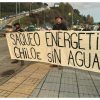Monday, May 6, 2024
News and Views from the Global South
COLOMBIA: Displaced Women Build New Lives, Brick by Brick
Gloria Helena Rey
- “The City of Women”, in the northern Colombian municipality of Turbaco, 11 kilometres from the fortified walls of this tourist resort city, bears no resemblance to Federico Fellini’s 1980 film by the same name, or to the similarly dubbed Buenos Aires neighbourhood of Puerto Madero, where almost all the streets and public spaces are named for famous women.
These Colombian women, in contrast, are very real and still alive, and are making their own mark on the country. Displaced by war, survivors of massacres and crimes, some were victims of the paramilitaries, others of guerrillas or the state security forces. Colombia has the world’s second largest internally displaced population (after Sudan) – at least 2.5 million, according to government figures. Women account for 49 percent of the displaced.
The new community in Turbaco was built on the hard work of such women. Initially, eight founded the Liga de Mujeres Desplazadas (League of Displaced Women) in 1998, to get forced displacement recognised as a war crime, to seek humanitarian aid to improve their terrible health conditions and poor nutrition, and to reclaim their own rights and those of their families.
“Seeing the terrible poverty in the streets was unbearable,” remembers Patricia Guerrero, a lawyer displaced by threats in 1997, mother of three daughters and the driving force behind the Liga de Mujeres and this unique village.
Around 100 women joined her to begin construction in 2003, building their new lives brick by brick. They themselves manufactured the 120,000 cement blocks used in the 97 houses (78 square meters each), which now house the 500 people that give life to the five-block settlement.
The project, which included the cost of the land and the construction of the dwellings, was negotiated with the owner for more than a year and a half.
Guerrero obtained 500,000 dollars from the U.S. Congress to kick-start the process. Additional money came from the office of the United Nations High Commissioner for Refugees, the World Food Programme, the Spanish government, the Ford Foundation and other public and private organisations.
As soon as more funds come in, construction of new houses will continue, says Héctor Useche, administrative assistant director and Liga project coordinator.
Training is a key component of the initiative. Many of these women were peasant farmers or domestics before coming here.
“It was hard to learn how to make bricks, but I proved that women could do it,” says Niris Romero, a mother of five, and one of the 30 women trained in the skill. “I also worked on the beams of my house, and helped mould each column and make the mix to cement the blocks. I am happy – I have a roof and a trade.”
Some of her peers were trained as bricklayers or in agriculture – everyone received some kind of training. Two hundred Liga members who did not receive state housing subsidies underwent training and took part in productive projects and other activities during the construction phase. All have carried their training further, particularly in the field of human development.
“It was extremely hard to get this project off the ground,” says Guerrero, who, having secured the initial funding, negotiated the purchase of the land.
“Later, we came under attack: I was accused of doing it for personal gain, and people predicted I would fail. During the construction process, we were threatened, people were ‘disappeared’ and killed, and bodies were dumped on the surrounding land to scare us. They wanted to drive us out, whatever it took,” she remembers.
The husband of Simona Velásquez, 46, a mother of six who was displaced by the war three times, was killed with a machete while he was guarding materials used in the construction of the settlement. “They didn’t steal the materials, but the murder caused panic. Many of the women wanted to give up,” says Guerrero.
But they did not, “because it would have been like killing our last hope. That’s why we stayed,” says Nerlides Almansa, 48, mother of six and current co-ordinator of productive projects for the Liga and “City of Women”.
The women have since been nominated for the National Peace Prize, awarded to individuals or organisations that contribute to resolving Colombia’s four-decade armed conflict. The project’s success story has been held up as a model for other regions in the country.
The women’s families have also received training and awareness-raising classes. Guerrero describes a youth league and explains that work on the concept of masculinity is done with husbands. “We do not want abusive husbands, or children who will be drawn into the war or prostitution. Our community is grounded in ethical values, and we educate everyone on their citizen’s rights.”
The women have also laid in water pipes and built a day-care centre, Mujercoop – a co-op that encompasses part of the community’s brick manufacturing activity – and a community restaurant. In addition, they set up a credit fund to finance new micro-enterprises and subsidise education. In July, loans were approved for 11 new businesses and shoe-making training, says manager Roselí Cardona.
Before arriving in Turbaco, the women had lost everything, and their pride and dignity was in shreds. Many of them had been raped and had seen family members killed.
“I don’t like to dwell on the past. Today, we have peace, a roof over our heads and a future,” says Adelaida Amador, mother of five and one of the first to move to the area. She owns one of the community’s grocery stores.
Like most of the women in the new village, she has found the courage and strength to rise from the ashes of her old life.
“We are proud of what we have done,” says Marlenys Hurtado, a mother of three and a Liga member. “We carry with us all the trials and wounds of this war, but we have learned to look to the future, with dignity.”
But this “is just the beginning. We need to make our town and productive projects self-sustainable, and to create an economy based on solidarity. We also need to resolve the conflicts that will inevitably arise, and consolidate the community based on a foundation of rights, equality, and opposition to war and violence,” says Guerrero.
It is harrowing to see children, husbands or brothers or sisters murdered, or to discover the body of another relative, and then have to flee to save your own life. It is an almost unimaginable task to overcome fear, hunger, and social marginalisation and still pick oneself up and continue on. But somehow, these women have managed to do it.
Isabelina Tapias, 71; Doris Berrío, her husband and two children; and Ana Luz Ortega, and her husband and seven children, for example, were displaced by paramilitaries.
Tapia’s daughter was killed, Berrío and her family miraculously escaped death, and Ortega and her family fled when the killings had become routine in her community and her 12-year-old daughter was threatened with rape.
“We fled the guerrilla killings. We left everything and got out,” says Almansa.
Almansa now focuses her attention on planting corn, beans and vegetables and the quest for resources to improve the community’s crops. She gets her strength “from the quality of the people who lead the project, those who support them, and from within myself. This was the only dream I had.”
>From afar, the modest houses and tropical vegetation form a quiet, green, deep wine, and yellow landscape, but the community itself has made some noise. It is a powerful sound, and, “above all, a strategy of peaceful resistance to impunity, violence against women and children, and murder,” says Guerrero.
“It is also a way to stand up to those who ‘disappear’ people, steal land, or who, for decades, have sown the seeds of pain and hunger in these regions.”

 Print
Print



